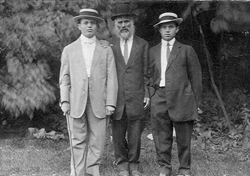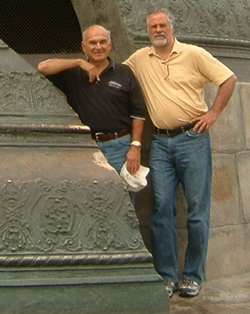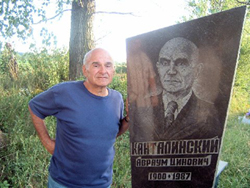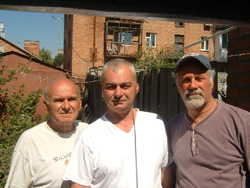 |

|
SEARCHING FOR FAMILY ROOTS When my paternal grandfather Avrum Kantelinsky passed through Ellis Island on October 14, 1908, While it is understandable that my grandfather's generation wanted to forget their humble beginnings and focus only on the promise of life in America, they also made it virtually impossible for our family to trace our roots. The only impressions many Americans of Jewish heritage have of life in the "shtetls" (Jewish villages) of Eastern Europe are the images portrayed in the Broadway musical "Fiddler of the Roof." Although my grandfather subsequently brought his father Shlomo Kantelinsky and three younger siblings to the U.S., their lives in Linitz, a shtetl some 150 miles southwest of Kiev, remained a closed book to my father's generation and to mine. That is, until 2007. Through a series of very fortunate events, in July, 2007 I was able to travel back to Linitz (now called Ilintsy in the new independent Republic of Ukraine) and actually discover a family line of relatives we believe to be descendants of a brother of my great grandfather. I have always been interested in genealogy, so when a second cousin, Rick Kolinsky, invited me to join him on a trip to "the homeland", Rick is a high school teacher in Portland, Oregon, who is quite adept at web design and is also a fledgling filmmaker. He has already created a web site of our family history (www.kolinskyfamily.com) and is in the process of making a documentary film of our trip. My job was to do as much research as I could on Linitz so we would know what to expect when we got there. Unfortunately, there was virtually nothing of substance recorded as the entire Jewish population of about 2000 had been wiped out and the synagogue closed after the Nazis occupation of July 23, 1941. I could uncover no record of any Kantelinskys on voters' lists or town documents. So when we arrived in Ilintsy, the most we hoped to find were the remnants of the synagogue and perhaps an old Jewish cemetery. But as luck would have it -- we call this "bashert", meaning fate or destiny in Yiddish - we were not in the town more than five minutes when our driver and interpreter Maxim made a contact through a local cab driver with a young Jewish man named Alik, whose immediate family had escaped the Holocaust and who had returned to Ilintsy after World War II. His parents had emigrated to Israel and his brother to Canada. Alik told us there were five Jewish families now living in Ilintsy and he offered to take us to the former synagogue, which was now part of a furniture factory. Since it was Sunday, the grounds were closed but Alik did manage to remove a lock from a basement room that once served as a Jewish school. I imagined that my grandfather may have been a student in this small gloomy space. While we never did get to see inside the former synagogue, our efforts attracted the attention of a next door neighbor, who, to our shock, informed us that the previous owner of her house was Avrum Kantelinsky, a man with the same name as my grandfather. This Avrum died in 1987 and his widow Fania and daughter Luba had moved to Israel. Could this be a relative? Certainly, we would have known if there had been family in Ukraine or Israel after all these years. But then again, perhaps not. By this time, another neighbor joined the conversation and informed us that Avrum was buried in the Russian Orthodox cemetery in town and not the old Jewish cemetery, which had been left derelict after the war. What we discovered at the cemetery virtually stopped us in our tracks. In fact, there was a greater resemblance between us than I have with any of my relatives in the U.S. and Canada - including my parents! What followed next was a miraculous series of events that made it quite clear that our search for roots was truly "bashert". When the Soviet Union fell in 1991, houses of worship which had been closed for decades were reopened and returned to the various religious communities. This included the central synagogue in Vinnitsa, the capital of the Ukrainian province where Ilintsy is located. The community had also appointed a Chairman for Jewish affairs, Isaak Novoseletskiy, whose office is located in the synagogue. Through Isaak's efforts and those of his wife, who just happens to work in the local Archives, we quickly learned that our "newly discovered" Avrum and three of his children had survived the Holocaust by escaping from Linitz through a 7-mile tunnel to a nearby village. His first wife and eldest daughter were not so fortunate and were executed by the Nazis on May 24, 1942. We also discovered that Avrum had a daughter-in-law, Svetlana, living in Vinnitsa and we were able to contact her through the local telephone directory. A visit with Svetlana was immediately arranged and we drove directly to her home in great anticipation of meeting a "lost" family member face to face. I could never have been prepared for what happened next. When we arrived at Svetlana's home, WOW!! This was Igor "Kontalinski", Svetlana's son and grandson of Avrum - and likely my third cousin. Igor now lives in Germany, but it was fortunate for us that he was back home in Ukraine at this time visiting his mother. Although it appeared that our genealogical search was over when we met Svetlana and Igor, in fact, our work had only just begun. What followed has been an exchange of photos and information with newfound relatives in Ukraine, Russia, and Israel and a search for others who may have escaped the Holocaust. With time, I am confident we will uncover more information and find other relatives. After all, this mission is truly "bashert". |
Photo Gallery
History of Jews in Ilintsy
Search for Family Roots
Kolinsky Family History Haberman Family History
Oral History of Illintsy
Genealogy Conference
Jewish Gen Homepage ShtetlLinks Directory JewishGen-erosity
Search the JewishGen Ukraine Database
Compiled by Rick Kolinsky and Richard Kollins
Updated: 12/20/2008
 he not only left the "old country" behind, he also left all recollections of our family history in Czarist Russia.
he not only left the "old country" behind, he also left all recollections of our family history in Czarist Russia. I jumped at the opportunity. I had never met Rick previously but we discovered our mutual passion for family history when we began corresponding on the internet last spring.
I jumped at the opportunity. I had never met Rick previously but we discovered our mutual passion for family history when we began corresponding on the internet last spring. There was the gravestone with a life-sized head-and-shoulders etching of Avrum Kantelinsky and who did he look like? Me!
There was the gravestone with a life-sized head-and-shoulders etching of Avrum Kantelinsky and who did he look like? Me! we were greeted by a handsome man in his mid-40s who seemed somewhat familiar to me. I quickly realized that his face bore a striking resemblance to the face I see when I look into a mirror.
we were greeted by a handsome man in his mid-40s who seemed somewhat familiar to me. I quickly realized that his face bore a striking resemblance to the face I see when I look into a mirror.